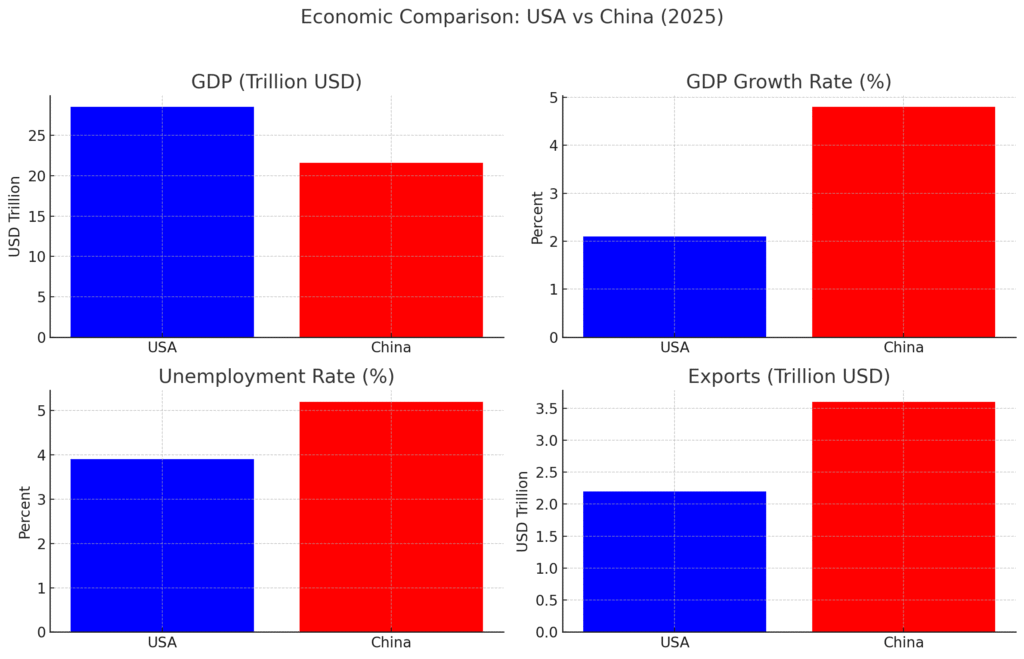China vs USA: Economic War in 2025 – Who’s Winning?
China vs USA: The world is at a turning point in 2025. The US and China, the two biggest economies, are in a fierce competition that goes beyond trade. This ongoing struggle, which is often called a “economic cold war,” has an effect on trade, technology, finance, and strategic alliances around the world. Both countries want to be in charge of the next stage of global leadership, but the big question is: Who is winning this high-stakes economic war?

Historical Context: The Origins of the Rivalry
This fight for economic power didn’t happen all at once. It goes back to the early 2000s, when China’s quick rise as a global manufacturing centre started to threaten America’s long-held position as the world’s leader. Over time, the competition got tougher, especially during the trade war between the two countries from 2018 to 2019, when they both raised tariffs on each other.
The pandemic came next. COVID-19 changed the world’s economies by causing huge amounts of stimulus spending and breaking supply chains. By 2025, the competition has grown into a bigger fight over who will lead in technology, have the most power in the world, and be able to support themselves financially..
Key Economic Indicators: 2025 Snapshot
A quick comparison of current economic data reveals contrasting strengths:
| Metric | USA (2025) | China (2025) |
|---|---|---|
| GDP | $28.5 Trillion | $21.6 Trillion |
| GDP Growth Rate | 2.1% | 4.8% |
| Unemployment Rate | 3.9% | 5.2% |
| Exports | $2.2 Trillion | $3.6 Trillion |
It’s clear that the U.S. has a higher GDP and a lower unemployment rate, which shows that its economy is mature. But China’s faster growth and strong exports show that it is quickly catching up.
Tensions over trade and tariffs
Even though the bitter tariff wars of the Trump years have calmed down, both countries still have protectionist policies in place. The U.S. limits China’s access to important technology, such as semiconductors and AI processors. China is slowly depending less on imports from the United States, especially in agriculture, in response.
China, on the other hand, has expanded its trade partnerships, making ties with BRICS countries, Africa, and the Middle East stronger. Its Belt and Road Initiative (BRI) keeps improving infrastructure in the region and trade routes around the world. On the other hand, the U.S. is bringing industries back to the U.S. and working with Canada and Mexico on economic issues within regional frameworks.
Technology: The Core Battlefield
The competition in technology is the fiercest of all. Chinese companies like Huawei, BYD, and Alibaba are becoming more powerful in Asia, Africa, and Europe. The U.S. is still ahead in advanced AI, aerospace, and chip design, with companies like NVIDIA, Apple, and SpaceX leading the way.
The ongoing “chip war” shows how divided things are. The U.S. has strict export controls, but China is spending billions on its own semiconductor ecosystem in order to become completely tech-independent.
By 2025:
- The U.S. leads in global innovation patents and deep-tech breakthroughs.
- China leads in electric vehicle production, 5G deployment, and digital finance adoption.
Currency and Financial Systems: Dollar vs Yuan
Despite efforts to challenge it, the U.S. dollar remains the dominant global reserve currency, comprising over 60% of global reserves. This gives the U.S. unmatched financial leverage.
However, China has made strides in promoting the Digital Yuan and settling international trade in local currencies — especially with countries under U.S. sanctions. Moreover, with petro-yuan agreements and stronger BRICS alignment, China is carefully building a parallel financial network.
Global Alliances and Strategic Influence
Militarily and diplomatically, the U.S. still leads. Yet, China is rapidly catching up through economic partnerships. It has deepened relations with Russia, Iran, and African nations, while the U.S. strengthens NATO ties and forges new alliances in the Indo-Pacific, including India, Japan, Australia, and South Korea.
In 2025, China’s Global Development Initiative (GDI) rivals the West’s infrastructure projects, further expanding Beijing’s reach in the Global South. As a result, many nations are strategically balancing their relations between both giants.
China vs USA Who’s Winning in 2025?
There’s no clear-cut winner. Each country holds distinct advantages:
USA’s Edge:
- Highest global GDP
- Lower unemployment
- Dominance in innovation and high-tech sectors
- Continued trust in the U.S. dollar
China’s Strengths:
- Rapid growth in GDP
- Highest global export volume
- Manufacturing resilience
- Expanding digital currency use and trade networks
In essence, the U.S. still leads in wealth and innovation, but China’s speed, scale, and influence are accelerating at a remarkable pace.
Forecasts and Expert Insights
If things keep going the way they are, many analysts think that by 2030, China’s nominal GDP could be higher than the U.S.’s. But China has a lot of problems at home, like a lot of debt, an ageing population, and rising youth unemployment.
The U.S. is also having trouble with political divisions, a lot of debt, and sudden rises in prices. Its entrepreneurial climate, global alliances, and military power, on the other hand, are still very strong.
Conclusion: A Bipolar World Order
The trade war between the U.S. and China has changed the world in a big way. The U.S. is the leader in institutional strength and innovation, but China is the leader in trade growth and industrial output.
Instead of one winner, the world is entering a bipolar economic era in which both powers compete, have an impact, and sometimes work together. The countries that do the best in both areas to get the most out of their strategic and economic interests may be the real winners.










